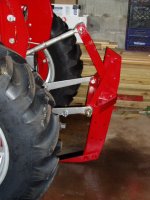Renze
Super Member
Last spring, we did our first attempt of what is called "min-till" in your continent: I think it is better described as ploughless tillage, because it consisted of 5 passes:
solving compaction problems on hard packed horse soil begins with something like this:
http://www.eversagro.nl/img/fotogalerijen/woelers/Java/images/MKet St tand en beitel 20cm.jpg
I can bury it to the frame in dry conditons with the 5245, which is 4 ton, 50 hp FWD. frame is about 80 cm or 32 inch. Tractor will dig in if going deeper than 25 inch.
Burying it will just leave a mess because clumps of sod will begin to plug up.
I mostly run the chisels just under the black topsoil layer (through the yellow subsoil) because the chisels wont create hard pan in the beach sand at 40 cm depth, and neither do horses, so as long as i'm under the topsoil layer, its deep enough.
Then a following pass with a 9 tine heavy cultivator, 2 meter wide, so tine spacing is 10 inch, working depth usually 15 inch.
Last year it was all mud, so we carefully broke it into big clumps with the subsoiler. This way the soil could dry, without making the wet soil too fine so it wont be like a sponge. Normally, working in wet soil is out of the question, but sometimes it just needs a helping hand to get dry enough to carry tractor wheels without rutting.
After the soil was dry enough to carry a tractor and give traction, i ran it at normal depth, and a week later with the 9 tine chisel, comparable to this:
http://www.hekamp.nl/files/Image/site/items/138/foto2.jpg
Then i spread a whole lot of manure, then chiseled again to loosen the manure spreader tracks.
Then i created a seedbed with our triple K cultivator with crumble roller.
The grass is doing fine, and there is no pooling anymore. The muck held moisture to get the young shallow grass roots going.
Just dont make the soil too loose when wet. Using a fine spaced cultivator on wet soil, is like stirring cement. When stirred wet soil cures, it gets even denser.
solving compaction problems on hard packed horse soil begins with something like this:
http://www.eversagro.nl/img/fotogalerijen/woelers/Java/images/MKet St tand en beitel 20cm.jpg
I can bury it to the frame in dry conditons with the 5245, which is 4 ton, 50 hp FWD. frame is about 80 cm or 32 inch. Tractor will dig in if going deeper than 25 inch.
Burying it will just leave a mess because clumps of sod will begin to plug up.
I mostly run the chisels just under the black topsoil layer (through the yellow subsoil) because the chisels wont create hard pan in the beach sand at 40 cm depth, and neither do horses, so as long as i'm under the topsoil layer, its deep enough.
Then a following pass with a 9 tine heavy cultivator, 2 meter wide, so tine spacing is 10 inch, working depth usually 15 inch.
Last year it was all mud, so we carefully broke it into big clumps with the subsoiler. This way the soil could dry, without making the wet soil too fine so it wont be like a sponge. Normally, working in wet soil is out of the question, but sometimes it just needs a helping hand to get dry enough to carry tractor wheels without rutting.
After the soil was dry enough to carry a tractor and give traction, i ran it at normal depth, and a week later with the 9 tine chisel, comparable to this:
http://www.hekamp.nl/files/Image/site/items/138/foto2.jpg
Then i spread a whole lot of manure, then chiseled again to loosen the manure spreader tracks.
Then i created a seedbed with our triple K cultivator with crumble roller.
The grass is doing fine, and there is no pooling anymore. The muck held moisture to get the young shallow grass roots going.
Just dont make the soil too loose when wet. Using a fine spaced cultivator on wet soil, is like stirring cement. When stirred wet soil cures, it gets even denser.
